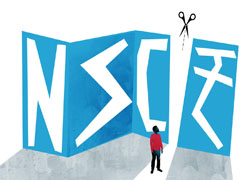Will I Get Loan for Son's Higher Education in MIT?
Ramalingam Kalirajan |10870 Answers |Ask -Follow
Mutual Funds, Financial Planning Expert - Answered on Jul 17, 2024
He has an MBA in finance from the University of Madras and is a certified financial planner.
He is the director and chief financial planner at Holistic Investment, a Chennai-based firm that offers financial planning and wealth management advice.... more

Sir my son is getting lower branches in nit but in mit Manipal he is getting cse I can only afford 1st year fees but not from 2nd year as my income is 5LPA with no collateral will i get an education loan for my son from second year onwards
Education Loan Overview
Collateral-Free Education Loans
Many banks offer collateral-free education loans. These loans are typically up to Rs 7.5 lakhs. However, for higher amounts, collateral might be required. Since you need a loan for the second year onwards, this could be a feasible option.
Eligibility and Requirements
The eligibility criteria include the student's academic performance and the course's credibility. Your son getting CSE at MIT Manipal makes him a good candidate. Banks will consider your income, but the main focus will be on your son’s future earning potential.
Evaluating Loan Options
Government Schemes
Check for government education loan schemes like the Vidya Lakshmi Portal. These schemes provide easy access to multiple loan options. They also offer subsidies on interest for economically weaker sections.
Bank Education Loans
Major banks offer education loans with flexible repayment terms. Approach them with detailed information about the course and the future earning potential of a CSE graduate. Banks are more likely to approve loans for high-demand courses like CSE.
Managing the Loan Repayments
Moratorium Period
Most education loans come with a moratorium period. This means you don’t have to start repaying the loan immediately. The repayment typically begins after your son completes the course. This provides financial relief during the study period.
Interest Rates and EMIs
Compare interest rates from different banks. Choose a loan with a reasonable interest rate. Post-graduation, when your son starts earning, he can take over the EMI payments. This reduces the financial burden on you.
Alternative Funding Options
Scholarships and Grants
Explore scholarship opportunities. Many institutions offer merit-based and need-based scholarships. Scholarships can significantly reduce the financial burden.
Part-Time Work
Your son can consider part-time work or internships. This can help cover some of his living expenses and reduce the amount needed for the loan.
Crowdfunding and Alumni Networks
Some students successfully use crowdfunding platforms to raise funds for education. Additionally, reach out to MIT Manipal's alumni network. Alumni sometimes contribute to scholarships or funding programs.
Assessing Future Financial Impact
Potential Earnings
A CSE degree from MIT Manipal offers strong earning potential. Graduates from this program often secure high-paying jobs. This enhances your son's ability to repay the loan comfortably post-graduation.
Return on Investment
Consider the return on investment. Investing in a quality education like CSE at MIT Manipal can lead to better job opportunities and higher salaries. This justifies taking a loan despite the initial financial strain.
Final Insights
Given your financial constraints, exploring collateral-free education loans is advisable. Government schemes and bank loans offer viable options. Utilize scholarships and part-time work opportunities to further reduce costs. The earning potential of a CSE graduate from MIT Manipal is high, making this investment worthwhile. By securing a loan and leveraging available resources, you can support your son's education and future career prospects.
Best Regards,
K. Ramalingam, MBA, CFP,
Chief Financial Planner,
www.holisticinvestment.in
You may like to see similar questions and answers below
Ramalingam Kalirajan |10870 Answers |Ask -Follow
Mutual Funds, Financial Planning Expert - Answered on Jul 16, 2024
Dr Dipankar Dutta |1837 Answers |Ask -Follow
Tech Careers and Skill Development Expert - Answered on Jun 24, 2025
Dr Dipankar Dutta |1837 Answers |Ask -Follow
Tech Careers and Skill Development Expert - Answered on Dec 05, 2025
Dr Shyam Jamalabad |108 Answers |Ask -Follow
Dentist - Answered on Dec 05, 2025
Dr Shyam Jamalabad |108 Answers |Ask -Follow
Dentist - Answered on Dec 05, 2025
Dr Shyam Jamalabad |108 Answers |Ask -Follow
Dentist - Answered on Dec 05, 2025
Dr Dipankar Dutta |1837 Answers |Ask -Follow
Tech Careers and Skill Development Expert - Answered on Dec 05, 2025
Ulhas Joshi |280 Answers |Ask -Follow
Mutual Fund Expert - Answered on Dec 05, 2025
Dr Dipankar Dutta |1837 Answers |Ask -Follow
Tech Careers and Skill Development Expert - Answered on Dec 04, 2025
Ravi Mittal |676 Answers |Ask -Follow
Dating, Relationships Expert - Answered on Dec 04, 2025
Anu Krishna |1745 Answers |Ask -Follow
Relationships Expert, Mind Coach - Answered on Dec 04, 2025
Anu Krishna |1745 Answers |Ask -Follow
Relationships Expert, Mind Coach - Answered on Dec 04, 2025
























